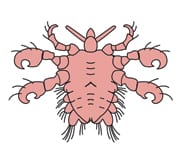Patient Basics: Body Lice
Originally published by Harvard Health.
What Is It?
Body lice are small, parasitic insects found mainly on the clothing of infested people, and occasionally on their bodies or bedding. Although they are related to head lice, and look almost exactly the same, body lice rarely infest the head hair. Instead, they spend most of their life on an infested person’s clothing, crawling onto the skin to feed on the host’s blood one or more times a day.
Female lice glue their eggs on the seams of clothing worn near the skin, where body heat allows them to hatch in about a week. A female louse can produce 300 or more eggs in her adult life, at a rate of about 10 per day. Eggs require temperatures between 75° and 100° Fahrenheit to hatch. Hatchlings develop to the adult stage in about nine days if they remain close to the host, but this can take as long as four weeks if the person takes the clothing off.
Most body lice are on homeless or destitute adults who rarely change their clothes. Children rarely have body lice.
Symptoms
An infestation with body lice often causes intense itching, which is an allergic reaction to their saliva. The reaction to the bites may appear as small welt-like marks and, possibly, redness and swelling, particularly around the neck and on the torso. A heavy, long-lasting infestation may produce a darkening and thickening of the skin, fatigue and other symptoms. Scratching the bites can lead to infection.
In certain underdeveloped and war-torn parts of the world and places with poor sanitation and overcrowding, body lice may transmit the microbes that cause trench fever, louse-borne relapsing fever and louse-borne (epidemic) typhus. Trench fever and endocarditis from this infection have emerged as diseases affecting homeless and destitute populations in large cities of North America and Europe.
Diagnosis
Body lice are unable to burrow into the skin. Although a few body lice may be seen clinging to body hairs, most are on the clothing of an infested person. Body lice and their eggs are most abundant along the seams of clothes worn close to the body.
Someone infested with body lice typically will have 10 or fewer active lice on their skin at any one time. But the clothing may contain many dozens or hundreds.
Infestations of body lice are more common in the winter months, when destitute people tend to wear many layers of clothing for long periods and have more contact with the clothing of others who may be infested.
Expected Duration
Body lice infestations can continue indefinitely without treatment. Body lice can be eliminated immediately by bathing and changing into clean clothing. Occasionally, treatment of the affected person’s skin with an insecticide is required.
Prevention
Body lice are spread by direct contact with infested people and their bedding or clothing. To prevent infestation, avoid sharing clothes and bedding and close, prolonged contact with an infested person. Infested people do not need to be quarantined to avoid spreading body lice. Body lice can survive for several days on clothing removed from a person.
In regions of the world where louse-borne infections occur, quarantines, mass inspections and treatments, and other extraordinary measures are sometimes required to stop outbreaks of louse-borne disease. Such efforts, however, are not needed in North America.
Treatment
The person needs to be washed from head to toe. The main way to eliminate body lice is by removing and washing or throwing away infested clothing and bedding.
Body lice and their eggs can be killed by washing clothing in very hot water, followed by drying these items in a clothes dryer set on high heat (more than 130 degrees Fahrenheit for at least 30 minutes). Dry cleaning or pressing the clothing with a hot iron will also kill the lice and eggs. Because body lice usually do not remain on the host, changing and/or washing clothes and bedding may be enough to eliminate these pests.
People with a lot of body hair may need to be treated with a pesticide (pediculicide) that can be applied to the body to make sure lice are eliminated completely. Over-the-counter pediculicides containing pyrethrum extracts or permethrin can be effective. Other pediculicides containing other classes of insecticides are available by prescription.
When To Call A Professional
If you suspect that you have body lice, consult with your doctor or public health officials to ensure proper diagnosis and to discuss treatment options.
Prognosis
Once body lice are eliminated, the skin irritation and other symptoms go away quickly.
Additional Info
Centers for Disease Control and Prevention (CDC)
1600 Clifton Road
Atlanta, GA 30333
Phone: 404-639-3534
Toll-Free: 1-800-311-3435
http://www.cdc.gov/

